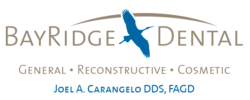Dental insurance (like any other insurance) can seem complicated and confusing.
Fortunately, Dr. Carangelo and the staff at BayRidge Dental in Webster, NY can help. They can help make sense of your dental insurance policy, benefits, co-payments, and other insurance-related matters. And they also offer an affordable dental discount plan as well. Here are a few answers to some of the most commonly asked questions about dental insurance…
How Does Dental Insurance Work?
As with other kinds of insurance, dental insurance works like this: your dental insurance provider pays for some of the costs for dental care – and you must pay the rest.
For example, most dental insurance providers (like BlueCross/BlueShield, Delta Dental, MetLife, Aetna, etc.) typically cover some of the costs. And you must pay for any remaining costs that are not covered by your insurance provider.
Who Files a Dental Insurance Claim?
BayRidge Dental Care makes handling dental insurance easy. As a courtesy to their patients, BayRidge Dental accepts most insurance plans and will estimate what your insurance provider will pay, and electronically file most claims on your behalf.
What Is a Dental Co-Pay or Co-Payment?
Typically, most insurance providers expect you to pay for part of your care and make a “copayment” or “copay” for short. The amount of your co-pay depends upon your dental insurance policy.
Once again, BayRidge Dental strives to make taking care of your teeth as easy as possible. And for payments, they accept cash, check, debit and credit cards (Visa, MasterCard, American Express, Discover, etc.). They also accept payments from flexible spending accounts – and offer generous discounts for pre-payment and to senior citizens.
DHMO, PPO, RDP – WHAT!?
Yeah… trying to understand the different kinds of dental plans can be a bit bewildering (and just in case you really wanted to know: DHMO stands for Dental Health Maintenance Organization; a PPO is a Preferred Provider Organization; and an RDP is a Referral Dental Plan).
But no worries, BayRidge Dental can help you figure out all the abbreviations and better understand your dental plan and benefits.
Coinsurance, Deductibles, and Maximums – Oh My!
Of course, we’d love to offer a simple explanation of dental insurance and dental benefits. But there are a few other things to consider and factor in as well, namely:
Dental Co-Insurance
As we mentioned before, as with most kinds of insurance (home insurance, car insurance, etc.), you may be required to pay for part of your dental costs in the form of “coinsurance.” For example, your dental plan may pay 80% of the costs for dental care. And if so, you’re required to pay co-insurance, the remaining 20% in the form of a copayment.
Dental Insurance Deductibles
Adding to the confusion, deductible amounts also need to be considered. Basically, a deductible is the amount you must pay before your insurance will pay for anything. For example, if your dental plan has a $500 yearly deductible, you are responsible for paying the first $500 in expenses – before your insurance will pay for any expenses. And it is only after you have paid the deductible amount that your co-payments are expected. In other words, you’re responsible for covering the costs of dental care up to your deductible amount each year. And if you’re expenses are more than your deductible, then your insurance will pay a portion, and you pay the rest (as a copay). But of course, all of this depends upon your specific dental coverage, plan, and dental benefits.
Annual Maximums
Lastly, there’s another key part of your dental insurance and dental benefits to consider. That is your annual maximum: the “maximum” amount your insurance will pay per year.
For example, let’s say someone has a dental insurance policy with a “pay-out cap” or “annual maximum” of $2,000. Now let’s suppose that their total dental expenses for this year are $2,200. If so, their insurance will pay up to the annual maximum ($2,000) and they will be expected to pay the remaining $200 (the amount above the $2,000 annual maximum).
If all of this sounds confusing (and it sure can be…) the American Dental Association (ADA) has several resources that explain more about dental insurance, dental benefit plans, and other important matters.
Regarding insurance maximums, it is also interesting to note that when dental insurance plans first came on the scene in the early 1970’s, plans usually had maximums of $1,000. Now some 45 years later, most plan maximums average $1,000 to $1,500 annually. Premiums have only increased since that time, yet given a conservative annual rate of inflation of just 4%, yearly benefit plan maximums should meet or exceed $5,000. This just goes to show that dental insurance is not what it used to be, and will therefore never be a cover-all, rather only a monetary aid to offset your dental needs,
BayRidge Dental: An Easier Way to Handle Dental Insurance Claims…
And if you’re in the greater Rochester area, luckily there’s a better way to sort through the details of dental insurance and dental benefits. Dr. Carangelo and the staff at BayRidge Dental in Webster, NY will gladly help answer any dental insurance questions that you may have.
And one last thing… as with any kind of insurance, dental insurance policies and benefits can vary greatly. So it’s important to know exactly what your dental insurance covers — and does NOT cover.

